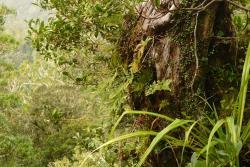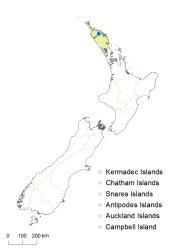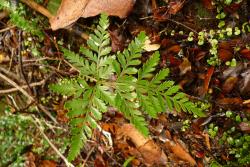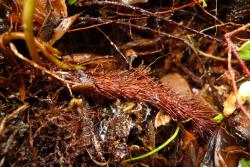Rhizome scales bearing setae along both margins from base to apex, but bearing multiseptate hairs only at the apices. False veins in ultimate lamina segments conspicuous when present, nearly always extending along the length of true veins from near their junction to their ending. Ultimate lamina segments usually bearing only 1 sorus per segment; apices of segments usually truncate.
Davallia tasmanii subsp. cristata is most easily distinguished by its rhizome scales, which have multiseptate hairs confined to the apices, whereas in D. tasmanii subsp. tasmanii they occur along both margins from base to apex (see von Konrat et al. 1999, fig. 4).
Northland.
Altitudinal range: c. 300 m.
Davallia tasmanii subsp. cristata is known only from one locality in Puketi Forest, Northland, where it was first collected in 1984 (Wright 1985).
Davallia tasmanii subsp. cristata grows on a rock bluff amongst mats dominated by Metrosideros perforata, and occasionally climbs Agathis australis, Podocarpus laetus, Prumnopitys ferruginea, and Weinmannia silvicola (von Konrat et al. 1999).
Davallia tasmanii subsp. cristata was given a conservation status of Nationally Critical by de Lange et al. (2013).
2n = 79, c. 76–80 (von Konrat et al. 1999).
Fertile fronds are apparently rare in the wild and have been collected only once (AK 211067), although they have been seen in cultivation.







